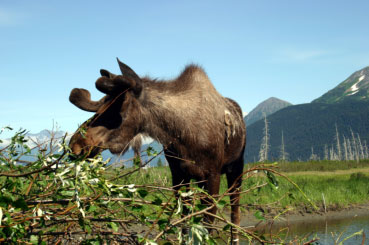Summer Wildlife Series: Moose

As Alaskans, we hold a special place in our hearts for moose. No matter how many times we’ve seen one, we still slow the car down and hang out the window to snap a picture, still peer out the door when one is munching on a sapling in the front yard. After all, you develop a special bond when you ride one to work every day. (Just kidding!) Since moose are one of the most popular members of Alaska’s wildlife family, we thought we’d give you a rundown of some fast facts, and more information on where you can spot them.
Moose are often number one on a traveler’s list of animals they want to see in Alaska – and that’s lucky, because moose are also one of the most common species to see, even in urban areas. There are 175,000 – 200,000 moose in Alaska. As the largest member of the deer family, they aren’t usually aggressive toward humans, but that doesn’t mean you shouldn’t practice caution when you see one. Cows (female moose) are extremely protective of their young, and the last place you want to find yourself is between a mother and her babies. Additionally, since Alaskans are accustomed to sharing their cities with wildlife, drivers are always on the lookout for “moose crossings,” even on highways.
The best thing you can do if you see a moose is to give it a lot of space, and never feed or approach it. Moose can range in size from 800 to 1,600 pounds, with a hide that varies from nearly black to a light golden brown. Baby moose are born with an auburn coat that they shed for a rust-colored one as their adult fur grows in.
Only bulls (male moose) have antlers and in September and October they “rut,” or fight each other with their horns to compete for mates. Cows give birth to calves in the spring, so keep your eyes peeled for adorable baby moose if you’re visiting Alaska in the early summer months! They can be seen following their mothers around on wobbly newborn legs. Cows commonly only birth one calf, but twins can happen if the mother is healthy and well fed. Baby moose weigh less than 30 pounds, but grow to be ten times that size in only five months. By fall, calves have been weaned so that the females can start breeding again.
Moose generally don’t live for more than 16 years in the wild. They are herbivores, and feed off of various vegetation including willow, birch and aspen. While moose can be found throughout the state, from Southeast to the Arctic slope, they are more heavily concentrated along the major rivers of Southcentral and the Interior.
When traveling in Alaska, whether you’re in an alpine meadow or in the heart of downtown Anchorage, don’t forget to keep an eye out for moose. You never know when – and where – you’ll spot one!
Back to Blog